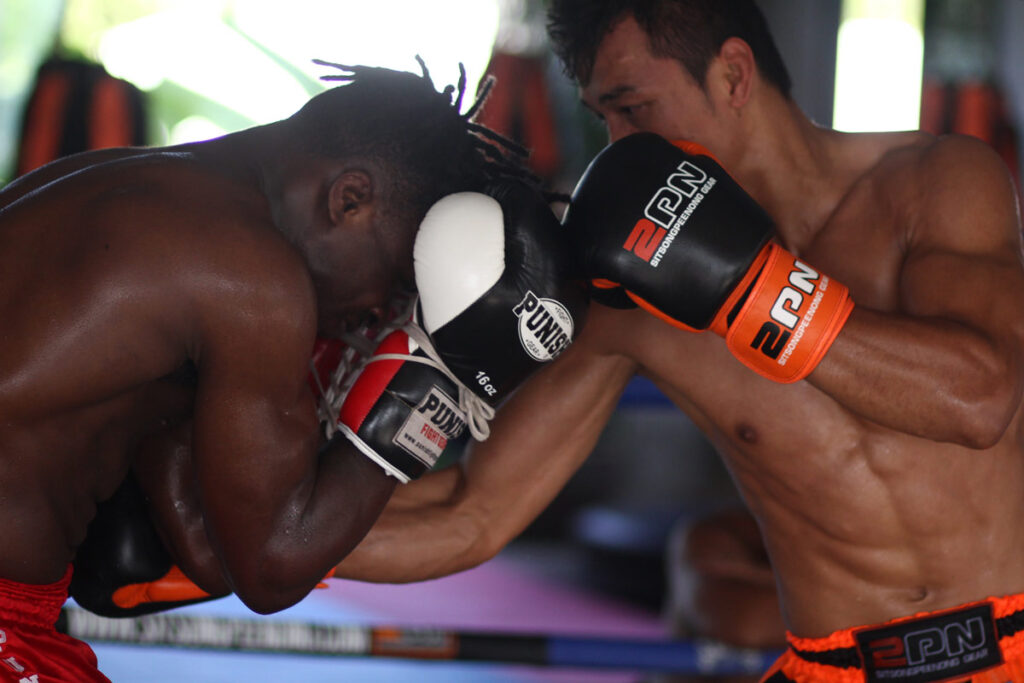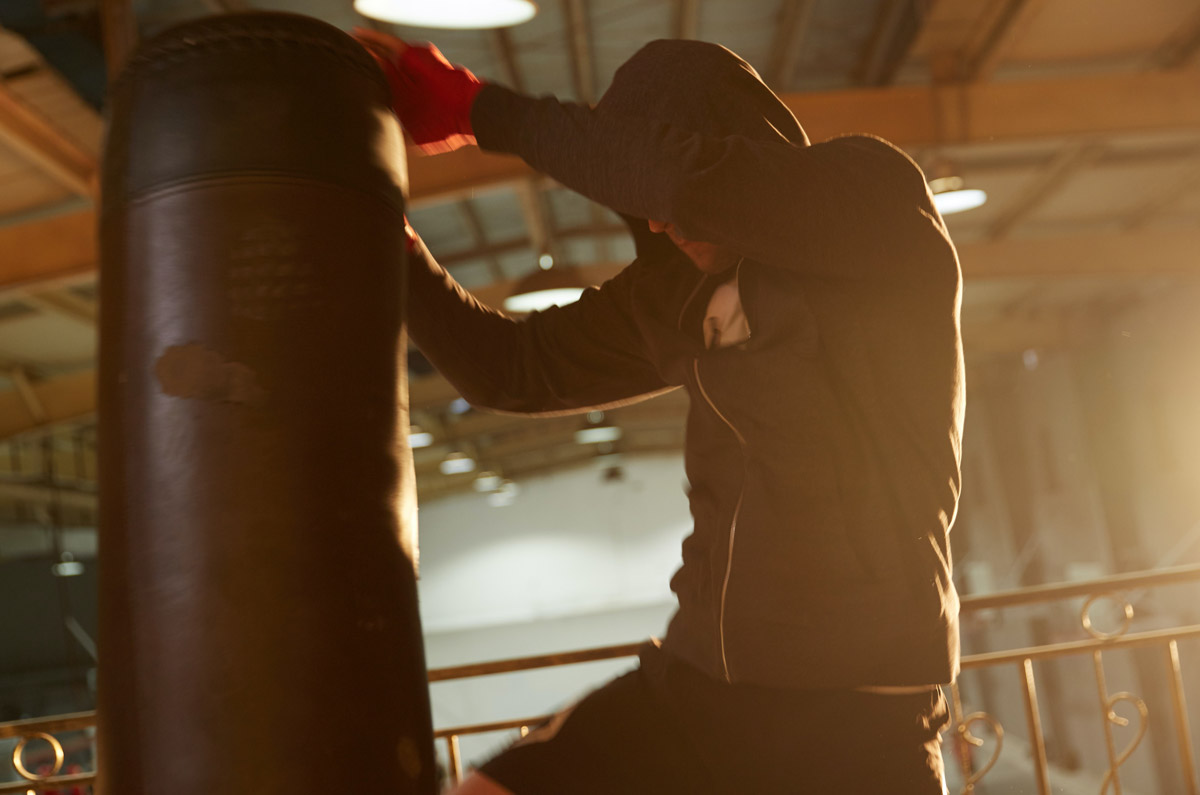Muay Thai training is a great way to get in shape.
Plus you get to learn some other cool stuff like kicking, elbow strikes, knee strikes, and basic boxing techniques.
Let me explain.
- What is Muay Thai Training Like?
- A Typical Muay Thai Warm Up
- Some Good Muay Thai Stretches
- Common Muay Thai Training Workouts to Help With Technique
- Beginner Muay Thai Training Tips
- How to Prepare for Your First Muay Thai Lesson?
- What Do You Need to Train Muay Thai?
- Can you Train Muay Thai at Home?
- Online Muay Thai Training
- Muay Thai Training Summed Up
What is Muay Thai Training Like?
Muay Thai training can be incredibly intense and for most, require a significant amount of dedication to have healthy habits outside the gym.
If newish to the sport, a quality Muay Thai training session is not really something you can jump into right off the couch.
It requires a high fitness level, and if you take a couple weeks off, you’ll certainly feel it when you return.
But this makes it very rewarding if you’re able to maintain a steady schedule and train 2-3 times a week. If you do, you’ll probably get in the best shape of your life in no time, and it helps make Muay Thai for kids or anyone else a great choice.
But just want to share one caveat to not be fooled. It is totally common in Southeast Asia for Muay Thai trainers to appear fat, out of shape, and know how to party. They may even smoke cigarettes in the gym. But don’t be fooled, there is a powerful 6-pack under that bulbous physique. Learn more in our guide to training muay thai in Phuket!
A Typical Muay Thai Warm Up
Before you begin any heavy training, it’s important to warm up your muscles and get your heart rate up early.
A couple of great ways to do this is by jogging or using a jump rope.
How to use a Jump Rope for a Great Muay Thai Training Warmup
This isn’t the playground activity of your childhood. To make the most of jump rope in the context of a Muay Thai training warm up, it’s recommended to use a heavy plastic rope.
This adds multiple benefits to the exercise strengthening your hands, arms, shoulders, and even neck.
Ideally, you’ll want to do this for at least 10 minutes.
A great warm-up is doing 5 sets of 2 minutes with no more than a minute’s rest in between each set.
Jogging
Jogging, of course, is another great warm-up.
A simple warmup can include an easy 10 to 20-minute run, although someone serious about training or at Tiger Muay Thai may start their workout with a 90-minute run!
This obviously takes time, though.
And if you’re just getting started, you can certainly jog at your own pace and even stop to walk to get at least 10 minutes of warm-up in.
Some Good Muay Thai Stretches
No quality warm-up is complete without some stretches.
And since Muay Thai empowers you to use 8 weapons on your body, it’s best to stretch out all muscle groups.
To do this properly make sure to identify the stiffest parts of your body and carefully get into a position where you can increase relative intensity.
You can rotate between static and dynamic stretches. However, trends are moving towards only dynamic stretches. But really it’s up to you.
Hip Stretches
For instance, if your hips feel stiff, you can try getting down onto your knees and with your hands behind you for support, push your hips up as you lean back as far as you can.
Shoulder Stretches
With any combat sport, you’ll want to take good care of your shoulders. And with Muay Thai, shoulder mobility is key for effective striking.
Common Muay Thai Training Workouts to Help With Technique
Give these bad boys a try:
Heavy Bag Training
One of the first things you should do when a boxing beginner gets into Muay Thai is train with a heavy bag.
It’s a terrific way to develop your striking muscle memory and stamina. Plus, it’s excellent for your striking power and shin conditioning.
As you practice first individual shots and then combinations, make sure you’re moving around to also practice footwork. It takes a while to get used to it, but it is an excellent and safe way to practice technique.
Similar to pads, you’ll probably want to start with a relatively soft bag, if necessary, even filled with fabric, before slowly moving up to harder bags/pads with less give.
And make sure to check out the different types of punching and heavy bags so you can choose the best one for your needs.
Pad Training
The big benefit of pad sessions with a training partner is that you also develop distance control and timing.
As you move around with your partner or trainer, you’ll be able to practice individual shots like an elbow strike or combinations. You can first start with basic strikes like jab, straight, and hook, and then move on to body strikes.
With pad training, you can better develop technique along with your stance, balance, and guard.
In fact, you’ll ideally want your partner to look for holes in your guard and lightly tap you to improve your overall defense. This is also great for training counter-strikes.
If you want to take it to an even higher level, the person holding pads can switch up their stance to simulate different fight styles.
An easy and great example of this is, is having the pad holder move forward like an aggressive fighter.
Shadowboxing (Technique Training)
The keep to getting benefits out of shadowboxing is visualization. You should also practice shadowboxing to improve your technique without hurting yourself.
(As long as you don’t overextend yourself and hurt your joints!)
Practicing the visualization of an actual fight is a helpful skill as a mental exercise and a footwork training exercise.
And it can actually be a great exercise that tests your gas tank.
If you’d like to take your boxing skills to the next level, try the Oculus VR boxing game mentioned in our boxing gifts list.
As you continue to do it, first in front of a mirror to watch yourself, you’ll eventually gain familiarity and comfort with the movements and then can move on to the next stage.
Sparring

Hard sparring is not 100% necessary unless you’re trying to be a professional fighter. However there are absolute benefits to moving around with a training partner in a simulated ‘fight’.
It’s a very interesting thing. You may watch fighting on TV and assume the footwork is easy enough, even if you just hit pads or the bag or even just shadowbox. But if get in there with a Thai boxer who actually fights or spars, you’ll likely feel like an uncoordinated tub of lard.
That’s why Muay Thai sparring sessions are so important. They’ll help you practice the movements of a fight.
That way, even if you don’t intend to compete, you can better use Muay Thai for self defense.
Beginner Muay Thai Training Tips
I think the best beginner tip I could give would be to avoid a beginner injury.
And a great way to do this is to leave your ego at the door.
You’ll have to regardless, and this isn’t to say you’ll be beaten up if you don’t. What I mean is to listen to instructions and not go into training thinking you’re going to look like a Muay pro after one session.
People increase injury rates because they overextend a punch and cause wrist injuries or hurt another joint trying to punch too hard.
During boxing training, these can be common injuries even when going over basic techniques.
So what I highly recommend is to go in with open curiosity as if you were a baby learning a new skill.
Take your time and focus on technique before trying to rival Mike Tyson.
How to Prepare for Your First Muay Thai Lesson?
Like other
And a big thing to consider before your first Muay Thai training session is cardio.
If you’re anything like me, you’ll likely be doing new movements relatively quickly in an attempt to generate power and appease your ego. This will drain your endurance faster than you may think.
So one big recommendation before you begin training is to grab a jump rope. That could be a light jump rope to get used to the exercise at first, but ideally, you’ll eventually want to get a heavier rope.
As you jump rope a few times a week or even every day for longer periods over time, you should be ready to take on a training session without fear of throwing up.
You may also be curious about your shin bone. Perhaps wondering if you should try to condition it before joining, but please don’t.
Your bag and pad work will certainly do a better job of conditioning your shins than any wooden stick or whatever else you try.
What Do You Need to Train Muay Thai?
One of the beautiful things about Muay Thai is that you really don’t need much to train it.
Hand Wraps
Hand wraps are key if you plan on actually punching anything because they’ll protect your knuckles and help avoid an aggravated wrist injury.
One way to help is to get an extra long hand wrap and make sure to wrap your wrists tightly with enough protection to ensure they won’t easily sprain.
Muay Thai Boxing Gloves
You’ll need some gloves to put over your hand wraps. We’ve gone over this in our Muay thai boxing rules article, but it’s worth noting here that when getting into training, it’s typically recommended to use 12 to 14-ounce gloves for the extra padding.
This is also important when sparring. If people are a bit slim, they can use 14 ounce gloves, while those a bit heavier can use 16 oz gloves.
Generally, especially among competitive fighters, the size of gloves depends on the size of the fighter.
- 105-126 lbs (47-57 kg) typically use 6-ounce gloves.
- 130-147 lbs (58-66 kg) use 8-ounce gloves.
- 154 pounds (67-70 kg) use 10-ounce gloves.
And in case you were wondering, yes muay thai boxing gloves are different from regular boxing gloves. This is because the use of the Thai clinch requires relatively greater flexibility to move your hand within the glove.
Shin Pads
As you start sparring with your training partners, you’ll likely want to use some shin pads to protect you from shin injuries when kicking or checking a kick.
This will stop you from cutting your shin up, but it’s still possible to get a bad shin bruise. But that’s nothing to worry about.
Belly Pad
As you continue along your journey, you’ll begin training body shots, teeps, and various other Muay Thai kicks.
A good belly pad is great to have if you have a training partner to wear it.
Can you Train Muay Thai at Home?

While it may be relatively difficult to do authentic training at home, you certainly can.
Especially if you have a training partner who can hold pads for you and ideally also has a Belly Pad.
And if you don’t have access to a pad holder, you can always order a heavy bag for your home.
This heavy bag training will not only help you nail down technique and condition your shins but also is a great way to let off some steam.
If you don’t have anything and don’t have the money to get them, you can still work on technique by shadowboxing.
Online Muay Thai Training
Muay Thai is an ancient martial art steeped in tradition. It originates from Muay Boran and Muay Chaiya, tracing as far back as 16th century Siam (Thailand’s previous name).
But the beauty of today’s world is that you can follow this ancient tradition online from the comfort of your own home.
Muay Thai Training Summed Up
So there you have it. You have somewhat of an idea about Muay Thai training and what a Muay Thai workout looks like.
Hope it helps you on your journey and hope you get a lot of benefits from your training.
